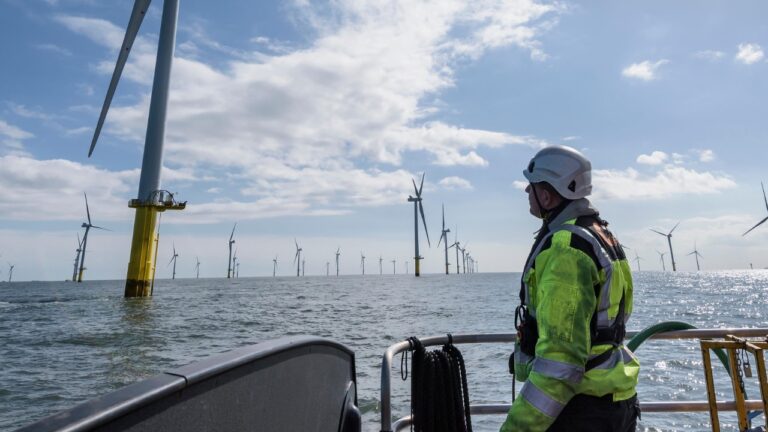
Mike Jones
Senior Fellow, Economics and Social Policy
In the eyes of many, 2021 was an extraordinary year for environmental politics. Within hours of becoming president, Joe Biden announced that the U.S. would be re-joining the Paris agreement. Meanwhile, in Glasgow, a twelve-day summit on climate change was wound up with promises on all sides, including a commitment to phase-down the use of coal. Globally, these events took place against a backdrop of record-breaking fires, heatwaves and floods.
At the beginning of 2022, the dust is settling, and a question that was difficult to figure out in 2021 – ‘what difference will all this make in terms of jobs and industry?’ – becomes easier to answer. Discussions about the role of government in shaping new markets are at the centre of the Government’s White Paper on Levelling Up. This paper argues, among other things, that a “green industrial revolution” will revive Britain’s precarious economy and reverse the decline of non-metropolitan Britain. To succeed, Levelling Up will require an industrial policy that places non-polluting clean energy technologies at its centre.
Naturally, all this intervention will come at some cost to the taxpayer. Market forces alone cannot deliver the high risk and often serendipitous projects needed to boost technological innovation; they are largely the result of strategic investments between the public and private sectors. Indeed, nearly all recent technological breakthroughs— from GPS navigation to touch screen technology and voice recognition in smartphones —required a massive push by the state.
From a national perspective, the case for a sustained industrial policy is compelling. There are glaring regional imbalances in the British economy and an evident lack of preparedness to respond to energy crises, such as the shortage of natural gas in 2021. These point to underlying weaknesses in the way the economy is structured.
It is important not to romanticise the role of government and its ability to effect change. Any critic of industrial policy can identify a string of costly failures – Concorde, British Leyland, the British Steel Corporation, Alfred Herbert, etc. To those immersed in the economic history of the 1970s, industrial policy is synonymous with rent-seeking and political capture.
On the other hand, government intervention played a crucial role in the development of key industries in East Asia—a fact that can be seen in many of today’s well-known brands: the likes of Toyota, Mitsubishi, Samsung, and Hyundai. These policies built on legacies of long bureaucratic traditions and considerable pre-war experience in state-directed development. Thus, it is simply not true that governments always fail. Equally, the IMF’s laissez-faire approach in the 1990s contributed to the Asian financial crisis of the late 1990s.
In the context of the UK, green policies are viewed as providing poorer regions with a head-start in new industries and a competitive advantage in global markets. Look around most local authorities and you will find a smorgasbord of government schemes designed to encourage renewable energy use. Notable examples include the Sustainable Warmth Fund and the Green Homes Grant Local Authority Delivery Scheme.
While these are all fine as far as they go, what the White Paper essentially lacks is a framework for putting all of this together. There are no clear benchmarks for success, nor any explicit mechanisms for reversing course when things go wrong. Civil servants will be able to design incentives appropriately only if they know enough about market dynamics. This requires a certain degree of embeddedness in industry, or what Peter Evans has called ‘embedded autonomy’. As the British record shows, severe government failure is a very real possibility. Neither liberalisation nor intervention per se is guaranteed to lead to a “green industrial revolution”: what counts is the quality of intervention.
On the positive side, BEIS can make a difference by leveraging its massive network of knowledge and business acumen – making things happen that otherwise would not. Indeed, some of what the government proposes in the White Paper could be effected by a simple executive decision. Other reforms, especially the parts dealing with “missions” and cross-agency collaboration, can be worked out through an iterative process of trial-and-error.
A truly radical levelling-up agenda, however, must also include a commitment to building new ‘gigafactories’ (battery power plants), as well as small modular nuclear reactors (SMRs) and a comprehensive network of public EV chargepoints. The faster this technological transformation takes place, the bigger the economic windfall. A team of mathematicians at Oxford University has concluded that the net gain from turbo-charged decarbonisation will be between $14 trillion (£10 trillion) and $26 trillion (£19 trillion).
In a nutshell, the Government must lead—not by simply fixing market failures but by actively embracing an explicit industrial policy. Such a policy is more likely to overcome the typical imperfections in market information than one that is implemented haphazardly or under the radar screen. In the words of Harvard economist Dani Rodrik:
“Mistakes are an inevitable and necessary part of a well-designed industrial policy programme; in fact, too few mistakes are a sign of underperformance. What is needed, instead, is a set of mechanisms that recognizes errors and revises policies accordingly.”
It is far too soon to say for certain whether the Government will succeed in its mission to Level Up, and there are many serious obstacles ahead as we enter a crucial stage of the post-pandemic recovery. But this much can be said: If Levelling Up is to be more than just a political slogan, it must be based on a comprehensive and coordinated green industrial strategy. Current approaches need to be rethought: there needs to be government intervention, but the right sort of intervention.


